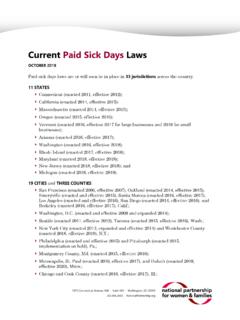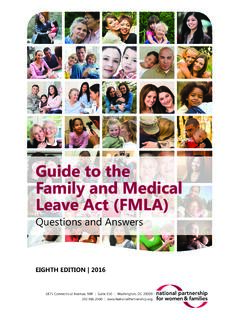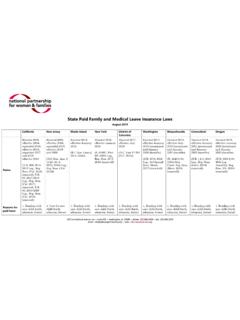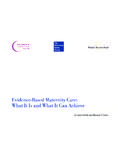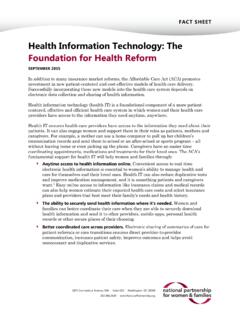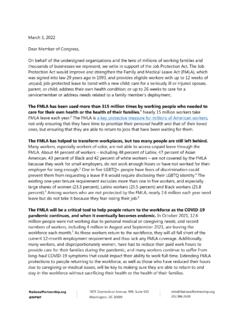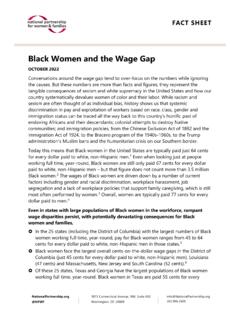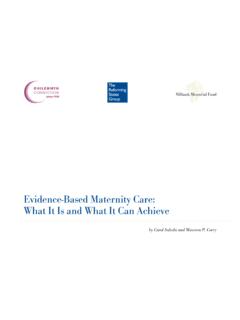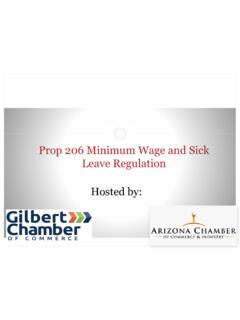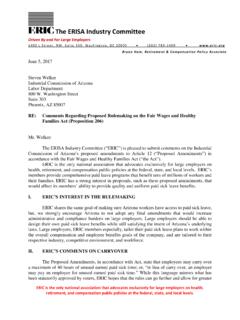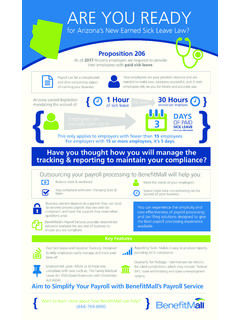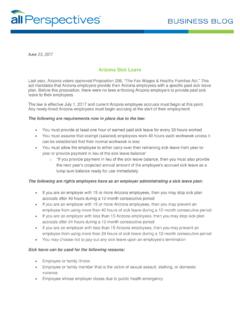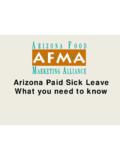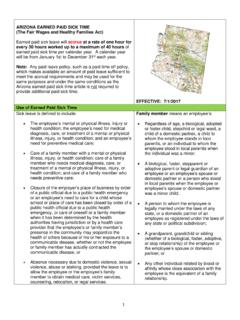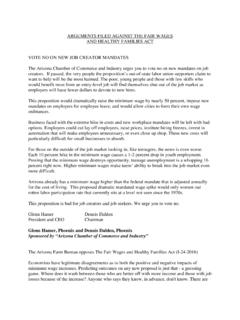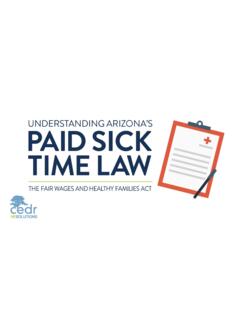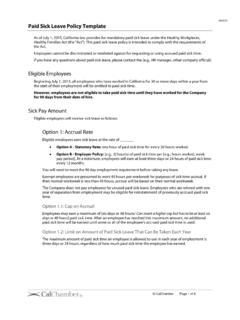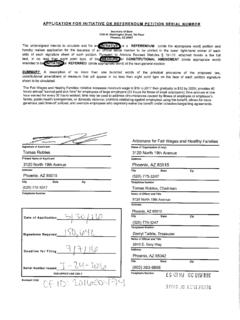Transcription of Paid Sick Days State and District Statutes
1 1 paid sick Days State and District Statutes Updated April 2020 (For City and County Laws, Click Here.) Key: EE: employee; ER: employer; SB: small business; LB: large business; FTE: full-time equivalent; DV: domestic violence; SAFE: safe time coverage; PHE: public health emergency; CBA: collective bargaining agreement Location District of Columbia Code (2008, amended 2013) (effective 2014) Connecticut (2011) (effective 1/2012) California (2014, amended 2015 and 2016) (effective 7/2015; 2016 expansion effective 7/2018) Massachusetts (2014) (effective 7/2015) Oregon (2015) (effective 1/2016)1 Vermont (2016) (effective 1/2017 for LB, and 1/2018 for SB) arizona (2016) (effective 7/2017) Washington (2016) (effective 1/2018) Rhode Island (2017) (effective 7/2018) Maryland (2018) (effective 2/2018) New Jersey (2018) (effective 10/2018)2 New York (2020) (Accrual effective 9/2020) (Benefits effective 1/2021) Summary EEs accrue one hour of paid sick time for every 37 to 87 hours worked and can accrue and use up to three to seven days, depending on ER s size.
2 EEs in certain industries receive one hour for every 43 worked and can accrue and use up to five days regardless of ER size. Covers sick Enumerated EEs whose place of business has 50 or more EEs accrue one hour of paid sick time for every 40 hours worked and can accrue and use up to 40 hours. Covers sick time for EE or family members care and for absences associated with domestic EEs accrue one hour of paid sick time for every 30 hours worked and can use up to 24 hours and accrue up to 48 hours. ERs may use alternate accrual method if accrual is regular and provides a sufficient amount of time. Beginning in 2018, in-home supportive services EEs accrue paid sick time at EEs whose place of business has 11 or more EEs accrue one hour of paid sick time for every 30 hours worked and can accrue and use up to 40 hours.
3 All others receive equivalent unpaid time. Covers sick time for EE or family members care and for absences associated with EE or dependent EEs whose place of business has 10 or more EEs (six or more EEs if ER is in a city with population above 500k, so that Portland s law remains in effect) accrue one hour of paid sick time for every 30 hours worked, and can accrue and use up to 40 hours. All others receive equivalent unpaid time. Covers sick EEs accrue one hour of paid sick time for every 52 hours worked and can accrue or use up to 24 hours in 2017 and 2018, and 40 hours in 2019 and following years. Workers in small businesses begin to accrue and use time in 2018. Covers sick time for EE or family members care (including long-term care EEs accrue one hour of paid sick time for every 30 hours worked.)
4 EEs whose place of business has 15 or more EEs can accrue and use up to 40 hours per year. All others can accrue and use up to 24 hours per year. Covers sick time for EE or family members care, absences EEs accrue one hour of paid sick time for every 40 hours worked. Covers sick time for EE or a family member s care, absences associated with EE or a family member s domestic violence, sexual assault, or stalking, closures for public health reasons. EEs of ERs with 18 or more EEs accrue one hour of paid sick time for every 35 hours worked and can accrue and use up to 24 hours in 2018, 32 hours in 2019, and 40 hours in 2020 and beyond. ERs who employ fewer than 18 EEs are not required to EEs whose place of business has 15 or more employees accrue one hour of paid sick time for every 30 hours worked and can accrue up to 40 hours in a year and 64 hours at any time, and can use up to 64 hours in a year.
5 All others receive equivalent unpaid time. EEs accrue one hour of paid sick time for every 30 hours worked, and can accrue up to 40 hours in a year. Covers sick time for EE or family members care and for absences associated with EE or family member s care; absences associated with EEs accrue one hour of sick time for every 30 hours worked. EEs whose place of business has four or fewer employees and whose place of business has a net income of less than 1 million dollars can accrue up to 40 hours of unpaid sick time; EEs whose place of 1 Oregon s law preempted the ordinance that was enacted by Eugene, Ore.; Eugene s ordinance was no longer in effect as of January 1, 2016. 2 New Jersey s statewide law superseded previously passed local paid sick days laws when it went into effect in October 2018.
6 2 Location District of Columbia Connecticut California Massachusetts Oregon Vermont arizona Washington Rhode Island Maryland New Jersey New York time for EE or family members care and for absences associated with domestic violence, sexual abuse or stalking. violence or sexual assault. the same rate, and can use eight hours per year, gradually increasing to 24 hours per year. Covers sick time for EE or family members care and for absences associated with EE s domestic violence, sexual assault or stalking. child s domestic violence. time for EE or family members care, for Oregon family leave purposes, for reasons related to a public health emergency and for absences associated with EE or minor child/dependent s domestic violence, sexual harassment, assault or stalking. appointments for parent, grandparent, spouse or parent-in-law), absences associated with EE or family member s domestic violence, sexual assault or stalking, and closures for public health or safety reasons.
7 Associated with EE or family member s domestic violence, sexual violence, abuse or stalking, closures for public health or safety reasons, and care for EE s or family member s exposure to a communicable disease. allow workers to accrue paid sick days but must allow use of unpaid sick time of up to 24 hours in 2018, 32 hours in 2019 and 40 hours in 2020. Covers sick time for EE or family members care, absences associated with EE or family member s domestic violence, sexual assault or stalking, and closures for public health or safety reasons. Covers sick time for EE or family members care and for absences associated with EE or family member s domestic violence, sexual assault or stalking. EE or family member s domestic violence, sexual assault or stalking, closures for public health emergencies or attend child s school-related conference or meeting.
8 Business has five to 99 employees can accrue and use up to 40 hours of paid sick time; EEs whose place of business has 100 or more employees can accrue up to 56 hours of paid sick time. Covers sick time for EE or family members care and for absences associated with EE or family member s care; absences associated with EE or family member s domestic violence, family offense, sexual offense, stalking or human trafficking. Law/Bill Number et seq. Public Act 11-52 Cal. Labor Code 245, Mass. Gen. Laws ch. 149, 148(c), (d) ORS , 21 Vt. Stat. 384, 481-485, 345; 29 Vt. Stat. 161 Ariz. Title 23, Ch. 2, Art. 8, 23-363, 23-364; Title 23, Ch. 2, Art. RCW , , , H. 5413 0001 A1827 S. 7506-B/A. 9506-B 3 Location District of Columbia Connecticut California Massachusetts Oregon Vermont arizona Washington Rhode Island Maryland New Jersey New York Impact Approx.
9 220,000 workers formerly without sick time gained it through this Approx. 200,000 workers formerly without sick time gained it through this Approx. million workers formerly without sick time will gain it through this Approx. 900,000 workers formerly without sick time will gain it through this Approx. 473,000 workers formerly without sick time will gain it through this Not yet determined. Approx. 60,000 workers were without paid sick time before the law s passage, but carve-outs create challenges in estimating the number who will gain Approx. 934,000 workers formerly without sick time will gain it through this Approx. 1,000,000 workers formerly without sick time will gain it through this Approx. 100,000 workers formerly without sick time will gain it through this Approx. 750,000 workers were without sick time before the law s Approx.
10 Million workers formerly without sick time will gain it through this Approx. million workers formerly without sick time will gain it through this Exemptions Does not apply to independent contractors; students employed by their higher education institution for less than 25 hours/ week; health care workers in premium pay programs; volunteers that engage in activities of an educational, charitable, religious, or nonprofit organization; Does not apply to EEs not employed in one of the 68 enumerated service occupations or by ERs with fewer than 50 EEs; salaried or exempt workers; temporary workers; certain State EEs; manufacturing ERs; nationally chartered nonprofits ( , the YMCA) Does not apply to EEs of any governmental entity who receive a retirement allowance and are now reemployed without reinstatement into retirement system.
